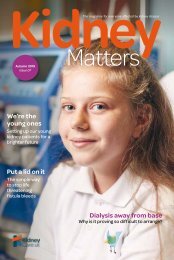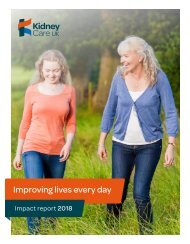Kidney Matters - Issue 6, Summer 2019
Kidney Matters is our free quarterly magazine for everyone affected by kidney disease. This issue includes another recipe for our Kidney Kitchen as well as articles about dialysis transport, UK Kidney week, conservative treatment, and an interview with a retiring dialysis nurse after 33 years. We know that being a kidney patient can be tough at times and that accessing the right help at the right time isn’t always easy. We’ve spent a great deal of time over the past year talking to kidney patients on dialysis, asking them what we can do to address this. The response was overwhelmingly ‘improved communication’ on what is going on in the kidney world and what is available to them in terms of support and how to access it. Kidney Matters has been developed to tackle this as well as the many other issues kidney patients face in day-to-day life. Along with shared patient experiences, Kidney Matters provides on how to access emotional and practical support, financial assistance through our grant schemes, advice from leading kidney specialists and tips on how to keep as well as possible by eating a healthy diet whilst on dialysis.
Kidney Matters is our free quarterly magazine for everyone affected by kidney disease.
This issue includes another recipe for our Kidney Kitchen as well as articles about dialysis transport, UK Kidney week, conservative treatment, and an interview with a retiring dialysis nurse after 33 years.
We know that being a kidney patient can be tough at times and that accessing the right help at the right time isn’t always easy. We’ve spent a great deal of time over the past year talking to kidney patients on dialysis, asking them what we can do to address this. The response was overwhelmingly ‘improved communication’ on what is going on in the kidney world and what is available to them in terms of support and how to access it.
Kidney Matters has been developed to tackle this as well as the many other issues kidney patients face in day-to-day life. Along with shared patient experiences, Kidney Matters provides on how to access emotional and practical support, financial assistance through our grant schemes, advice from leading kidney specialists and tips on how to keep as well as possible by eating a healthy diet whilst on dialysis.
You also want an ePaper? Increase the reach of your titles
YUMPU automatically turns print PDFs into web optimized ePapers that Google loves.
12<br />
C O N T I N U E D<br />
healthy people lose about 1 ml/min or 1% of kidney<br />
function each year. So the people in the trial were<br />
losing their kidney function at a very high rate, and we<br />
were able to dramatically reduce this loss, not quite<br />
back to normal, but certainly very significantly.”<br />
The benefits seen in the study do not appear to be linked<br />
to lower blood glucose levels. In fact, the effects on<br />
blood glucose were less than that seen in other studies.<br />
“Because SGLT2 inhibitors act through the kidney,<br />
their ability to reduce blood sugar levels falls as<br />
kidney function declines. Despite this, we saw these<br />
profoundly beneficial effects on the kidney. I now<br />
describe SGLT2 inhibitors as kidney drugs, rather than<br />
medicines to lower glucose,” says Vlado.<br />
Is the treatment safe?<br />
In CREDENCE, canagliflozin seemed to be safe with no<br />
unexpected side effects. There is known to be a higher<br />
risk of thrush with SGLT2 inhibitors, because they<br />
increase the amount of glucose in the urine. This can<br />
usually be treated easily with a topical cream and there<br />
is no need to stop the medication.<br />
The only other cause for concern in CREDENCE was<br />
diabetic ketoacidosis, a serious condition that occurs<br />
when the body produces high levels of blood acids,<br />
called ketones. This is uncommon in people with type 2<br />
diabetes, but is more frequent with SGLT2 inhibitors.<br />
“Everyone with diabetes<br />
should have their kidney<br />
function tested each year”<br />
Glucose<br />
Figure 1: SGLT inhibitors and the kidney<br />
Blood<br />
<strong>Kidney</strong>s normally<br />
reabsorb glucose<br />
back into the body<br />
Vlado adds: “In the trial, diabetic ketoacidosis occurred<br />
in 11 people treated with canagliflozin compared to one<br />
person receiving placebo. Everyone recovered, but it is<br />
something we need to keep in mind. However, there were<br />
none of the other adverse effects seen in other studies<br />
that might have been associated with SGLT2 inhibitors,<br />
such as fractures or amputations. This suggests that<br />
treatment with canagliflozin was overall very safe.”<br />
Reabsorption of<br />
glucose is blocked<br />
by SGLT inhibitor<br />
The blood takes<br />
glucose to the kidneys<br />
Glucoses now passes<br />
out of the body in the<br />
urine, so lowering blood<br />
glucose

















